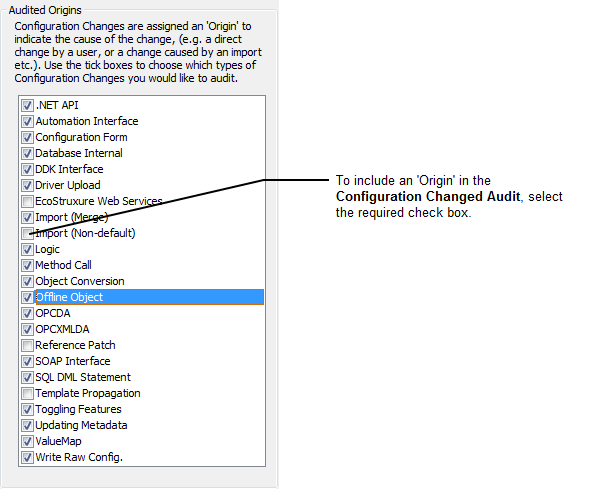The Auditing Origins settings allow you to choose which types of configuration changes are recorded. Each configuration change has an ‘origin’ which indicates the type of action or interface that caused the change to occur.
You can choose which types of configuration change are recorded on your system. Select the check boxes for those origins that correspond to changes you want to be recorded. Clear the appropriate check boxes for those changes you do not want to be recorded.

The origins are categorized as follows:
- .NET API—Changed made via a third-party client that uses the .NET API interface.
- Automation Interface—Changes made via the Automation interface.
- Configuration Form—Changes that are caused by users altering the settings on configuration Forms. For example, if you display a Point Form and change the address of the point, the address change will be recorded and will have a Configuration Form origin.
- Database Internal—Changes that ClearSCADA performs automatically in response to a change made by a user. For example, an outstation can contain points that have parent-child relationships. If a user reconfigures the parent point so that it is associated with a different outstation, ClearSCADA automatically associates the child point with the other outstation too. The user’s changes are associated with the Configuration Form origin, but the changes to the child point have the Database Internal origin.
- DDK Interface—Changes that are made via a DDK Interface.
- Driver Upload—Changes that are caused by configuration data being uploaded from a device. For example, a device could be configured on one system and then physically moved to another location and connected to a different system. Rather than configure the settings for the device again at the second system, the relevant driver can upload the existing configuration settings from the device and apply them to the database. These changes would be associated with the Driver Upload origin.
- EcoStruxure Web Services—Changes that are caused by users altering the settings within the EWS Server via an EWS interface.
- Import (Merge)—Changes that are caused by a database item being imported into a database that already contains a version of the same item.
- Import (Non-default)—Changes that are caused by a database item that has non-default settings being imported into the database. (The database item does not already exist in the database).
- Logic—Changes that are caused by Logic programs. For example, an ST program could write to the configuration fields of a point - the changes written by the program would have the origin ‘Logic’.
- Method Call—Changes that occur as a result of a method (action) being performed.
- Object Conversion—Changes that are made as a result of a database item of one type being converted into a different type of database item.
- Offline Object—This origin is currently unavailable.
- OPCDA—Changes that are made either by:
- Third-party applications that use the OPCDA interface
Or:
- Using the
OPC Data Bar to access a database item’s property, and then using the Set Value action to change the value for that property.
- OPCXMLDA—Changes made via third-party applications that use the OPCXMLDA interface.
- Reference Patch—Changes that are caused by a referenced item being deleted. When an item is deleted from the database, any items that reference the deleted items are updated. These updates are configuration changes with ‘Reference Patch’ origins.
- SOAP Interface—Changes made via third-party applications that use the SOAP interface.
- SQL DML Statement—Changes that occur as a result of an UPDATE, INSERT, or DELETE statement being used to make changes to your ClearSCADA database. The UPDATE, INSERT and DELETE statements can be issued via a third-party SQL based application such as SQL Server, or via QueryPad.
- Template Propagation—Changes that are caused by updates to the configuration of an item in a Group Template. The changes in the Group Template are applied automatically to the relevant Group Instances, and these alterations are classed as ‘Template Propagation’ changes.
- Toggling Features—Changes that relate to a feature that has its own aggregate being enabled or disabled. For example, when the Alarm Limits feature is enabled at the server, an Alarm Limits tab (aggregate) appears on the Point Form. If the Alarm Limits feature is disabled, the Alarm Limits tab is no longer shown. So changes that are caused by enabling or disabling the Alarms Limits feature at the server are recorded as having a Features origin.
- Updating Metadata—Changes that relate to user-created Extra Database Fields fields.
- ValueMap—Changes that relate to Value Maps which are used with Master devices and Slave outstations. When a Master device writes a value to a Slave, the Slave driver then updates the relevant Value Mmap item with the new value. If the new value is a configuration value, this change will cause a configuration change with a ValueMap origin to be logged.
- Write Raw Config.—Changes that relate to alterations that have been saved on any of the graphical editors, such as Trends, Logic diagrams, Schedules, Mimics (any configuration display except Forms).